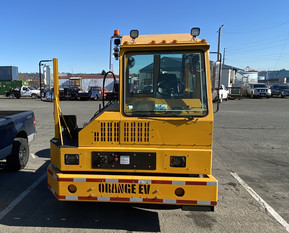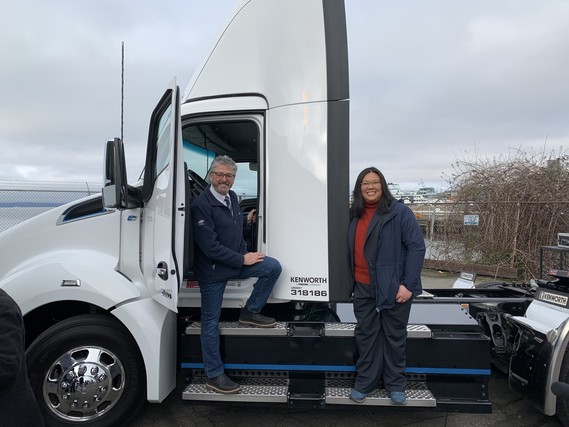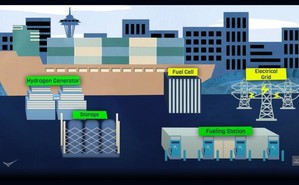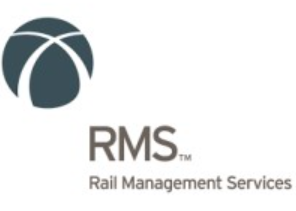|
Welcome to the Ports Clean Air Quarterly, the newsletter for port-related clean air and climate activities. This special “earth month” kick-off edition highlights some of the exciting projects happening at the Port of Tacoma, Port of Seattle, and the Northwest Seaport Alliance. Each newsletter will showcase projects and milestones across our gateway, highlight an industry or community partner who is focused on environmental sustainability, and provide additional opportunities for community engagement, such as bus tours, commission meetings, or upcoming webinars!

In March, three Orange EV battery-electric terminal tractors began operating at our South Intermodal Yard (SIM) in Tacoma. This marks the first deployment of zero emission cargo handling equipment in the Seattle-Tacoma cargo gateway. Three more electric terminal tractors will arrive by June, bringing the total to six. The new battery electric terminal tractors are displacing diesel-powered tractors, which will have their engines scrapped. Rail Management Services, the operator of the SIM Yard, purchased the terminal tractors with funding support from the EPA Diesel Emission Reduction Act program and incentive funding from Tacoma Power. More information can be found here.
|
 In January, cargo operations began at the newly renovated North berth of the Terminal 5 facility. South berth cargo activity is expected to begin in 2023 and as part of the Terminal 5 project, shore power infrastructure is being installed at both berths. Shore power capability allows ships to plug into the power grid while at the dock rather than running their engines.
In addition, we have developed an Air Quality Management program in collaboration with the Terminal 5 tenant, which will limit fine particulate matter emissions through the use of shore power and clean cargo handling equipment. For more information about Terminal 5, check out our informational video.
 Investments in zero-emission drayage trucks and cargo-handling equipment, as well as shore power installations on ship terminals, are great candidates for state funding under the Climate Commitment Act, according to a recently released report by Clean & Prosperous Washington.
The report, Washington’s Decisive Decade: An Emerging Roadmap for Transportation Decarbonization and Cleaner Air, “enhances our understanding of the potential of interventions to reduce pervasive sources of air pollution on our roads, in our ports, and across our waterways that impact both local and global communities, and our economic efficiency,” according to author Kevin Tempest, co-founder of the Low Carbon Prosperity Institute.
At the release of the report, Port of Tacoma Commissioner Kristin Ang shared, "The Northwest Seaport Alliance is glad to work alongside Clean & Prosperous Washington to move policy and funding opportunities toward greener investments for ports. Shore power capability, reducing drayage truck emissions, and installing zero-emission cargo handling equipment on our terminals are key components of meeting our zero-emission goal."
Learn more here.
*Picture featuring Port of Seattle Commissioner Fred Felleman and Port of Tacoma Commission Kristin Ang.

As a “landlord port,” at any given point the Port of Seattle has over 200 lease agreements with tenants for its waterfront properties that range from renting a parking space on a terminal to long-term ground leases where the tenant has rights to develop and use the property. To promote sustainable practices in tenant operations, the Port developed “green lease” terms to incorporate environmental and sustainability best practices into standard lease agreements. Some examples include requiring high-efficiency lighting and incorporating Port commitments to phase out fossil fuels from building heat and cooling. The Port began piloting these terms in new and renewing lease agreements earlier this year. Read More
|

As Ports and industry explore ways to transition away from fossil fuels, ports have the potential to be significant centers of activity for hydrogen with opportunities to fuel energy storage, heavy-duty transportation, and clean maritime fuels. The Port of Seattle is working with the Pacific Northwest National Laboratory and Seattle City light to study large volume storage of hydrogen and hydrogen carriers, with potential use cases including fueling for heavy duty vehicles and vessels. Read More
|

RMS is a longstanding partner of NWSA and provides intermodal services across the United States, conducting about 10 million “intermodal lifts” per year. An intermodal lift means loading or unloading containers, trailers, automobiles, etc. on and off rail cars. Currently, RMS is involved in a grant funded project to remanufacture six of their yard tractors at the Tacoma South Intermodal Yard (SIM) into battery electric zero-emission tractors, as well as installing the requisite charging infrastructure. This is the first time such a project is being done in the NWSA gateway. RMS is a leader in implementing zero emission yard tractors; by July 2022 they will have 31 tractors in operation across the U.S. with plans to do more.
For the partner profile, we interviewed Ed Morgenthaler, Vice President of RMS, for his perspectives on electrification and their electric yard truck project in Tacoma. We greatly appreciate Ed’s partnership in championing this project from beginning to end.
Mr. Morgenthaler gave 3 primary motivations for undertaking this project:
1.) To significantly reduce their environmental footprint by eliminating air pollutant and GHG emissions from ¾ of their yard truck fleet at the Tacoma SIM Yard.
2.) Electrification is the way of the future and getting involved earlier gives RMS more time to work out the kinks with the new technology and help contribute to a better electric products down the line.
3.) Electricity is a fraction of the cost of diesel, so with the right incentives to offset the high upfront cost of the electric yard tractors, going electric can create savings over the life of the vehicle.
Ed also shared some key advice for other companies interested in going electric, "The funding, resources, and support are available. While the paperwork and process can be intimidating, manufacturers and partners like NWSA can and want to help with the legwork and applications. You just have to go for it!"
Learn more about RMS here.
|
|